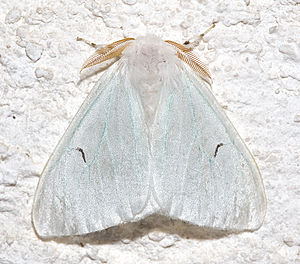Black L
| Black L | ||||||||||||
|---|---|---|---|---|---|---|---|---|---|---|---|---|

Black L ( Arctornis l-nigrum ), ♂ |
||||||||||||
| Systematics | ||||||||||||
|
||||||||||||
| Scientific name | ||||||||||||
| Arctornis l-nigrum | ||||||||||||
| ( OV Müller , 1764) |
The Black L ( Arctornis l-nigrum ) is a butterfly ( moth ) from the subfamily of the tussock moths (Lymantriinae) within the family of Erebidae .
features
The moths reach a wingspan of 35 to 45 millimeters. They have bright white, slightly translucent-looking forewings, on which a conspicuous black "L" can be seen approximately in the middle, offset to the front edge. Young animals have a turquoise sheen, newly hatched animals are completely green.
The caterpillars are about 50 millimeters long. Their body is somewhat flattened and colored red-brown or gray-brown with some yellow or orange marbling. The first three segments are heavily overgrown with numerous long rust-red and black hairs and thus appear significantly thicker than the rest of the body. On the body, on the sides and back of the fourth, fifth, ninth, tenth and eleventh segments, white tufts of hair grow. In addition, the animals have tufts of brown hair on the sixth to eighth segment.
Occurrence
The animals occur in almost all of Europe and Asia , east to Japan . They are absent in some parts of the Iberian Peninsula , the north and west of Great Britain and the far north. They live in light, not too old deciduous forests , especially on the edge, on warm slopes and in damp valley floors.
Way of life
The females lay their light green, flat (twice as wide as tall) and cylindrical eggs on top of the leaves of the forage plants. The solitary caterpillars hatch in September. In case of danger, they catapult themselves from the leaves by folding their bodies down in the middle. Due to their strong hair, they can fall unharmed from a great height. They overwinter in the foliage after two to three moults on the ground. They can be found in the following spring before the leaves have sprouted. At this time, they feed on dry leaves. Later they often sit freely on leaves. They pupate in loosely spun leaves on their forage plants at the end of May. Their pupae are colored in a striking turquoise green and have black markings.
The caterpillars are oligophagous and feed on the leaves of European beech ( Fagus sylvatica ), winter linden ( Tilia cordata ), pedunculate oak ( Quercus robur ), willow ( Salix caprea ) and other deciduous tree species.
Flight and caterpillar times
The moths fly in one generation from mid-June to mid-August. The caterpillars are found from September and after wintering until May of the following year. The nocturnal moths, especially the males, are attracted by artificial light .
swell
Individual evidence
- ↑ Manfred Koch : We identify butterflies. Volume 2: Bears, Spinners, Swarmers and Drills in Germany. 2nd, expanded edition. Neumann, Radebeul / Berlin 1964, DNB 452481929 , p. 86f.
literature
- Heiko Bellmann : The new Kosmos butterfly guide. Butterflies, caterpillars and forage plants. Franckh-Kosmos, Stuttgart 2003, ISBN 3-440-09330-1 .
- Hans-Josef Weidemann, Jochen Köhler: Moths. Weirdos and hawkers. Naturbuch-Verlag, Augsburg 1996, ISBN 3-89440-128-1 .
Web links
- www.lepiforum.de: Taxonomy and photos
- Moths and Butterflies of Europe and North Africa (English)
- Ian Kimber: Guide to the moths of Great Britain and Ireland (English)
- Arctornis l-nigrum at Fauna Europaea

